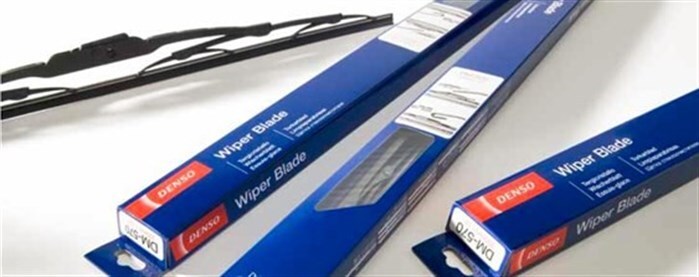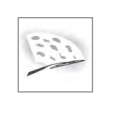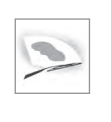How to: Install DENSO wiper blades

1. Are conventional, hybrid and flat wiper blades better suited to different types of vehicle, or is it just a matter of preference?
Whether you choose a conventional, hybrid or flat wiper blade design, each has their own benefits. Conventional blades are a tried and tested design which have seen decades of use – and can offer the most robust and durable performance. Pressure points within the blade’s design are evenly spread and allow for great wiping performance.
Flat wiper blades became popular in the early 2000s and offer an attractive appearance. They’re also slimmer and lighter than conventional blades, and they work by a mixture of aerodynamics and an internal metal vertebra which applies pressure to the windscreen.
Lastly, hybrid wipers combine the benefits of both technologies – with evenly spread pressure points and a slim design. DENSO is so respected in producing hybrid wiper blades, that Ferrari has chosen hybrid blades for a number of its models since 2004. DENSO’s design is also used on Japanese bullet trains.

Advanced, OEM specification DENSO Hybrid wiper blade
2. How often should a wiper blade be replaced?
DENSO recommends wiper blades are replaced every year, or even sooner if necessary. Wiping performance can be affected even after six months due to a range of external factors.
Replacing wiper blades at the right time ensures perfect visibility for drivers’ and passengers’ safety and preserves the integrity of the wiping system, as poorly performing blades create excessive vibration that can damage the wiper motor.
3. Will a wiper suffer performance penalties if the blade is not replaced in time?
Rubber deteriorates over time and all wiper blades need to be replaced eventually. Not only does rubber deteriorate, but the frame can too because of wear and tear. Other factors that cause wiper deterioration includes dirt from driving, UV rays and humidity. Even lack of use can cause poor wiper performance in warm temperatures.
4. What should customers be encouraged to look for, to know their wiper blades need replacing?

Streaking
Symptom: Narrow streaks are left on the windshield.
Cause: Foreign matter has attached itself to the rubber blade, or the edge of the blade is worn.
Remedy: First, clean the edge of the blade. If streaks still appear, replace the wiper blade.

Jumping
Symptom: The wiper blade does not move smoothly but vibrates noisily and bounces due to dirty windshield.
Cause: Incorrect arm angle or worn-out wiper blade.
Remedy: First, clean the windshield; then check the angle. If jumping persists, adjust angle and/or replace the wiper blade.

Unwiped Spots
Symptom: Wiper blade leaves one or more unwiped spots
Cause: Wiper blade deformation or rubber deterioration.
Remedy: Replace wiper blade.

Uneven Blade Pressure
Symptom: Wiper blade does not contact the windshield surface evenly, leaving a large unwiped surface.
Cause: Worn wiper blade.
Remedy: Replace wiper blade.
5. What are the key steps to removing an old wiper blade and installing a new one?
- Firstly, read the installation guide carefully.
- Clean the windshield manually (not with the old wiper blades).
- Ensure the new wiper blades are the correct ones. Some people realize this too late and, having removed the old ones in preparation – cannot fit them back onto the wiper arms.
- Lift the arm off the windshield to its highest point. Some cars’ wipers need to be moved to the service position or to 12 o’clock. This is because not all wiper arms are designed to be lifted in their normal ‘parked’ position and can be prevented from doing so by the hood.
- Remove the old wiper blades and inspect the wiper arms for corrosion and imperfections. If these are evident, seek professional advice to ensure their safety isn’t compromised.
- Gently place the arm back into position. Do not allow the arm to stand on its own or hit the windshield, as in both cases, the windshield will be damaged and likely need replacement.
- Take and prepare the new wiper – remove protective cover from the rubber, if present. Lift the arm again and install the wiper in accordance with the installation guide. Gently place the arm back into position.
- Try operating the wiper system while vehicle is stationary.
6. Are there any common mistakes to watch out for during this process?
The most common mistakes are easily avoided with extra care. They include not following the installation guide, not cleaning the windshield, and leaving the wiper arm up, which can easily snap back and damage your windshield.
7. What checks should you perform on a newly installed wiper blade?
- Firstly, check you’re confident the wiper blades are securely fitted to the wiper arms.
- Operate the wiper controls under normal conditions to check the wiper blades are performing correctly, using windshield washer fluid to lubricate the screen if necessary.
- A newly installed wiper blade should have no streaks, even pressure, no un-wiped areas, and no noise.
8. What sets DENSO’s wiper blade portfolio apart from the rest?
DENSO quality has been recognized and used as original equipment by several car manufacturers. Our wiper blades are the same quality, whether we supply to car makers or aftermarket customers, because DENSO’s ethos is that quality comes first.
DENSO has high standards of design and we source the best quality materials not only for our wiper blades, but for all our parts. This means we offer wiper blades of the highest standard so that our customers know that their high-quality product will not only perform when it needs to, even under harsh conditions, but it will also have a long lifespan.
